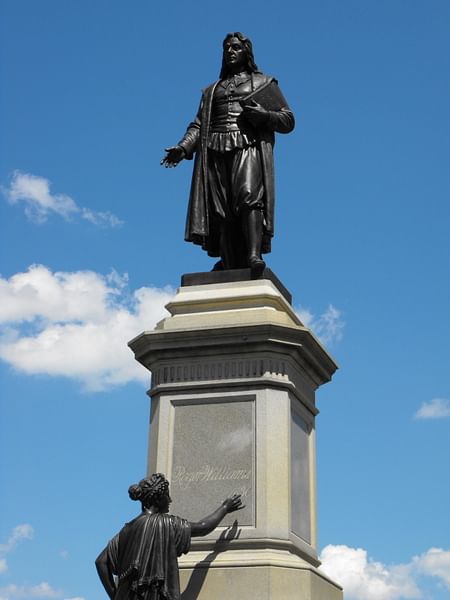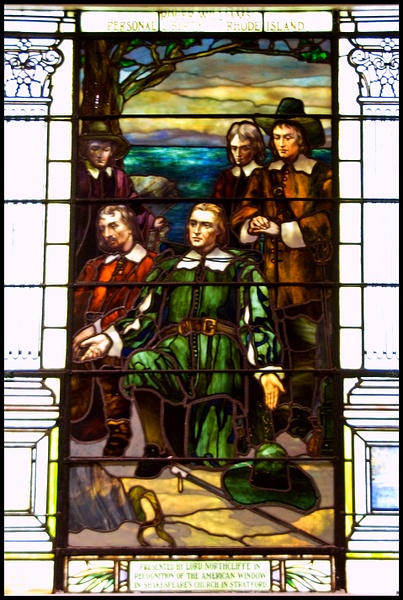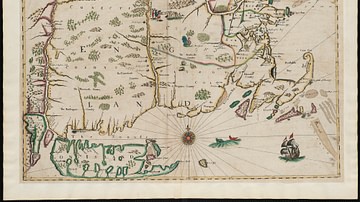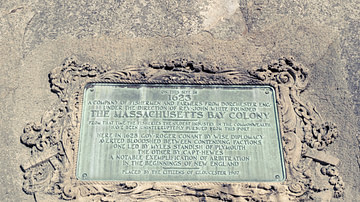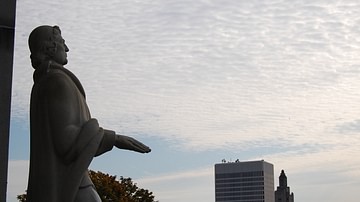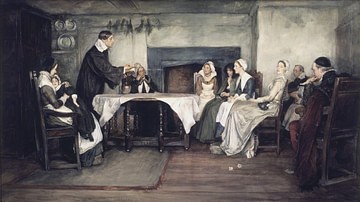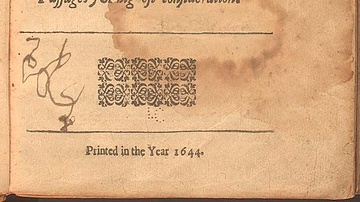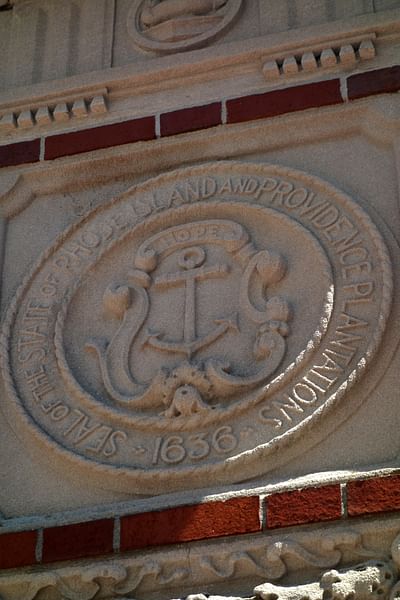
Providence Colony (also known as Providence Plantation, modern-day Providence, Rhode Island, USA) was a settlement established in 1636 CE by the Puritan separatist theologian and pastor Roger Williams (l. 1603-1683 CE) after he was banished from the Massachusetts Bay Colony. Williams objected to a number of policies pursued by Massachusetts Bay, as well as Plymouth Colony, especially the fusion of church and state and those related to Native Americans. He wrote a tract criticizing the policy of taking land from Native Americans without proper compensation c. 1632 CE and paid the asking price of the Narraganset tribe and the Wampanoag Confederacy for the land that became Providence in 1636 CE.
In 1638 CE, other religious dissenters from Massachusetts Bay arrived in the region, including Anne Hutchinson (l. 1591-1643 CE), William Coddington (l. c. 1601-1678 CE), John Wheelwright (l. c. 1592-1679 CE), and John Clarke (l. 1609-1676 CE). Hutchinson and Wheelwright founded Portsmouth while Coddington and Clarke, also co-founders of Portsmouth, would contribute to the establishment of both Providence and Newport. As these people had all been forced to leave their homes in Massachusetts Bay due to religious persecution, they founded their colonies on the promise of complete religious freedom, a decision which would shape the cultural atmosphere of Rhode Island as a whole in its formative years and afterwards.
Williams spoke the Native American's language fluently and served as their interpreter with the other colonies of New England. He persuaded the Narragansett tribe to side with the colonies against the Pequot during the Pequot War (1636-1638 CE) and declared Providence neutral during King Philip's War (1675-1678 CE) between the colonies and the allied Native American tribes. Both sides, however, ignored this repeatedly, and Providence was burned in 1676 CE. The colony was rebuilt, however, and continued under the charter Williams secured in 1644 CE until it was absorbed into the Dominion of New England (1686-1689 CE) but regained its independence after the Glorious Revolution in England in 1688 CE.
Providence Colony was famous (or infamous, according to the Massachusetts Bay Colony) for its adherence to Williams' original vision of individual freedom for its citizens and this was also adopted by the other Rhode Island colonies going forward. Providence struck one of the first blows against English control of North America in 1772 CE through their attack on the British ship Gaspee and, with the other colonies of Rhode Island, was the first to renounce allegiance to the crown in May of 1776 CE. They were also the last to ratify the U.S. Constitution, only doing so once revisions were made guaranteeing personal liberty and the separation of church and state.
Williams & the Puritan Colonies
The English colonies of New England were established after the Plymouth Colony was founded in 1620 CE and proved successful. Between 1620-1630 CE, a number of other attempts at colonization were made in the area around Plymouth, and the small settlement of Massachusetts Bay Colony was established in 1628 CE by the Puritan separatist John Endicott (l. c. 1600-1665 CE). In 1630 CE, John Winthrop (l. c. 1588-1649 CE) arrived as the second governor of the colony with 700 Puritan colonists aboard four ships and expanded it, moving the capital from Salem to Boston. He founded the colony on the vision of religious conformity and made clear that dissent would not be welcome.
Roger Williams arrived at Boston in 1631 CE and was welcomed by Winthrop and the other magistrates before they realized he did not share their vision. He left for Plymouth Colony and served as pastor there under their second governor, William Bradford (l. 1590-1657 CE), until 1633 CE when he parted ways with them over religious interpretation and practices. He felt Plymouth, like the Bay colony, was too legalistic and, further, had not sufficiently separated themselves from the Anglican Church, which both Puritans and separatists rejected as the 'true church'. Puritans (the founders of Massachusetts Bay) wanted to 'purify' the church of its Catholic aspects while separatists (who founded Plymouth) advocated a complete rejection of the Church and the establishment of independent congregations.
Williams, though a separatist, was more liberal in his views than most, and though he condemned the Anglican Church, he had nothing against individual Anglicans, nor others of any faith, which caused him problems with Massachusetts Bay and, to a lesser extent, with Plymouth. Williams was fluent in a number of languages and, while at Plymouth, he learned the Native American tongue and made friends with members of the Wampanoag Confederacy. In addition to his religious objections, he also criticized both colonies for taking land from the Native Americans without paying for it.
He returned to Massachusetts Bay in 1633 CE, serving as assistant pastor and then pastor of the Salem church, until he was called to court to answer for the above "strange opinions". Winthrop and the other magistrates brought him to court a number of times between 1633-1635 CE for sharing his thoughts with his congregation and finally banished him in 1635 CE. He was to be deported in early 1636 CE but fled the colony for Plymouth and then the Native American village of Sowams (modern-day Warren, Rhode Island), center of the Wampanoag Confederacy presided over by Massasoit (the title, meaning Great Chief, of Ousamequin, l. c. 1581-1661 CE) of the Pokanoket tribe.
Founding of Providence
He remained with Massasoit through the winter of 1636 CE and further developed a relationship with the neighboring Narragansett tribe (who were not a part of the Wampanoag Confederacy). Scholar Alan Taylor quotes Williams' view of this time, as contrasted with his experiences in the colonies:
Roger Williams conceded, "It is a strange truth, that a man shall generally find more free entertainment and refreshing amongst these barbarians than amongst thousands that call themselves Christians." Compared with the colonists, the Indians demanded less from their nature, investing less labor in, and extracting less energy and matter from, their environment. (191)
He purchased a plot of land from Massasoit for a colony at the head of Narragansett Bay on the Seekonk River and began to cultivate the land with a few followers who had joined him, modeling his settlement on those of the Native Americans. Plymouth Colony, however, claimed he was on their land – although they had never paid Massasoit anything for it – and, to avoid confrontation, he moved across the river to a no-man's-land between the Wampanoag and Narragansett which he purchased from the Narragansett chiefs Canonicus (l. c. 1565-1647 CE) and Miantonomoh (l. c. 1600-1643 CE). He named his new colony Providence, as he felt it had been granted by the goodness of God, and it became known as Providence Plantation ('plantation' meaning an agricultural community) or the Colony of Providence Plantation.
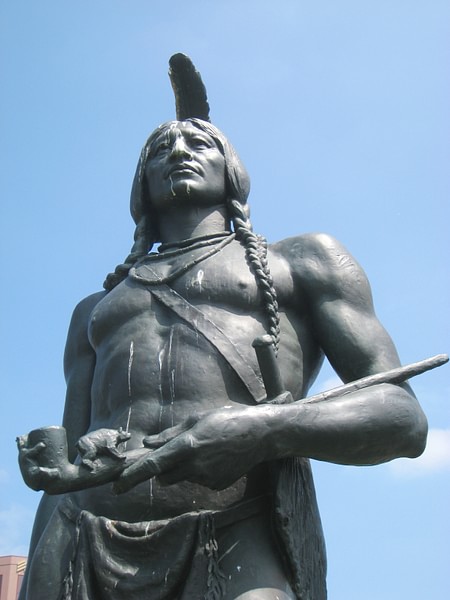
Peace & War
The establishment of Providence was beneficial both to Williams and his followers and to the neighboring Native Americans, as scholar David J. Silverman notes:
Both Ousamequin and the Narragansett sachem [chief] Canonicus, supported this move for similar reasons. For one, an English settlement would serve as a buffer against the other's raids. It would also provide them with readier access to English goods and services, including the use of Williams as a go-between and scribe in their relations with other tribes and colonies. As Williams told, the Wampanoags and Narragansetts used him as "their counselor and secretary…they had my person, my shallop and pinnace, and hired servant, etc., at command, on all occasions, transporting 50 [of their people] at a time." In other words, Williams, by virtue of living in their country, had become their resource. Over the next decade, Ousamequin granted Williams and other Rhode Island colonists the right to settle and use tracts all around the northern and eastern edges of Narragansett Bay and its islands within the Wampanoag-Narragansett no-man's-land. The Narragansetts did the same. (230)
Williams understood that the Native Americans had no concept of private property rights and did not see his payment to them as a sale. What he offered them was his service as a friend and ally and any valuables he gave to the chiefs he recognized as a gratuity. As Silverman notes, "Such transactions were not one-for-one exchanges of land for goods but a mutual pledge to sustain 'a loving and peaceable neighborhood'" which would be maintained by both sides, and their posterity, forever (231). Ousamequin offered the same terms to the later arrivals, such as Hutchinson and Coddington, and expected the same generosity of spirit from them as he had seen in Williams.
The peaceful relationship between the new colonists and their benefactors was tested early during the Pequot War of 1636-1638 CE. The Pequots were a tribe who lived in modern-day Connecticut on the coast of Long Island Sound and were not aligned with either the Wampanoag or the Narragansetts. In 1636 CE, John Endicott destroyed Pequot villages, without authorization from Winthrop, and started the conflict. The Narragansetts had long been the enemy of the Pequots, having lost land to them in earlier wars, but seem to have at first been uncertain who to support in the war. Williams convinced them to side with the English colonists of Massachusetts while also providing Winthrop with intelligence, through correspondence, on Pequot war plans (which he learned through his fluency in their language). Williams assured Canonicus of the good intentions of the colonists and reminded him of the enmity between his people and the Pequots, securing his pledge of assistance.
Although Williams was a friend of the Native Americans and their first real advocate among the early colonists, he was first and foremost an Englishman and owed allegiance to the other colonies. Further, the Native Americans were not a united, cohesive cultural entity and his obligations were only to the Narragansetts and Wampanoag Confederacy, neither of whom were friends to the Pequots. Williams has been criticized for his role in providing Winthrop with the plan for the Mystic Massacre of 1637 CE but, in doing so, he was showing himself as a friend not only to the Massachusetts Bay Colony but also the Narragansetts who took part in the raid.
Over 700 Pequots were massacred, mostly women and children, and the war ended soon after. Pequot survivors were sold into slavery locally or shipped to plantations in the West Indies. Williams condemned Massachusetts Bay for starting the war but, although he was an abolitionist, did nothing to stop the enslavement of the Pequots. The Narragansetts, however, saw nothing wrong with this since they would have done the same, and, further, with the destruction of the Pequots, they became the most powerful tribe in the region and took over the Pequot lands.
Development & Expansion
Williams established Providence as a haven for any, like himself and his followers, whose religious views conflicted with those of Massachusetts Bay and, later, Connecticut and other colonies. Williams believed in the primacy of liberty of conscience – the freedom to believe in whatever god one saw fit and practice one's belief without fear of persecution – and so drew other dissenters to his colony. Quakers and Baptists, who were persecuted elsewhere, came to Providence as did Jews and Catholics, and were welcomed.
The colony was censured by Massachusetts Bay and others as a haven for heathens, upstarts, and troublemakers but it flourished under Williams' vision. The colony's economy was based on agriculture but also trade in furs, timber, fishing, and, in time, shipbuilding. Its success encouraged expansion and William Coddington established Newport with John Clarke in 1639 CE. The next year, Newport was joined with Portsmouth as a single colony with Coddington as its governor.
The success of Providence did nothing to endear it to Massachusetts Bay – even though Williams and Winthrop were on good terms personally – and, by 1643 CE, the Bay Colony was attempting to annex those of Rhode Island. They were legally within their rights because they had a charter from the king while Williams only had an agreement with the Native Americans to support his claim to the land. Williams returned to England and secured a charter, returning in 1644 CE, and the colony was then safe from assimilation by the Bay colonies and expanded further. The new Rhode Island colonies were now known as Rhode Island and the Providence Plantations; Rhode Island referring to the Newport-Portsmouth colonies and Providence Plantations to Providence and neighboring Warwick.
The other colonies (Connecticut, Massachusetts Bay, New Haven, and Plymouth) had meanwhile formed themselves into the New England Confederation, and Coddington wanted his colonies to join. Williams prevented this by his charter and, after a few years of legal disputes, was elected president of the united colonies of Rhode Island and Providence Plantations. He made his vision for the colonies clear in his A Letter to the Town of Providence in 1655 CE which established the separation of church and state in governance and the primacy of freedom of religion for all citizens. The first Baptist church in the Americas and first Jewish synagogue were both established in the Rhode Island colonies and Quakers and Catholics, two of the most often persecuted Christian sects in other colonies, flourished there.
King Philip's War & Slavery
Although the Narragansetts and Wampanoag Confederacy had at first benefited from the colonial victory in the Pequot War, the arrival of more colonists afterwards resulted in the loss of more and more Native American land to settlements. Massasoit's son, Metacom (also known as King Philip, l. 1638-1676 CE), who had become chief in 1662 CE, finally grew tired of the many broken treaties and repeated theft of his lands and allied himself with the Narragansetts and others in the conflict known as King Philip's War. Williams again served as a go-between during the war, declaring Providence neutral ground, but it was burned in 1676 CE in a native raid. The colonists defeated the Native American coalition in 1678 CE, and afterwards, the tribes were moved onto reservations or left the region of their own volition.
Providence was rebuilt and again proved itself a resilient and successful colony. Williams' charter prevented any further attempts by other colonies to absorb his own and continued to thrive independently. Under King James II of England (also known as King James VII of Scotland, r. 1633-1688 CE), the colony was absorbed into the Dominion of New England in James II's attempt to exert more control over his North American holdings. When he was deposed in the Glorious Revolution of 1688 CE, Williams' charter again became the basis of the colony's government.
Although Williams was an abolitionist, and slavery was outlawed in 1652 CE, the slave trade – which had proven so lucrative to the Massachusetts Bay Colony and others – had gained a foothold and proved as profitable for Rhode Island colonies as it had for others. Anti-slavery laws remained on the Providence books but were never enforced. Williams himself, in fact, kept a young Pequot as a slave and returned runaway slaves to their masters in keeping with the biblical injunction, "Slaves, obey your earthly masters" (Ephesians 6:5), and the example of St. Paul returning the slave Onesimus to his master Philemon in the Book of Philemon. Providence became part of the Atlantic Triangular Slave Trade between New England, Europe, and West Africa, and, by 1774 CE, the Rhode Island colonies had a greater slave population than any other in New England.
Conclusion
At the same time they were enslaving others, however, they still maintained the ideal of freedom for all, a paradigm which would be maintained throughout all the North American colonies. On 10 June 1772 CE, Providence men attacked the British schooner Gaspee in one of the first acts of rebellion which led up to the American War of Independence (1775-1783 CE), and on 4 May 1776 CE, they were the first to declare their independence from Great Britain. After the war, Providence joined with the others in Rhode Island in refusing to ratify the Constitution until provisions were included guaranteeing personal liberties and the separation of church and state.
Rhode Island was admitted to the new union of the United States in 1790 CE, with Providence as its capital, as State of Rhode Island and Providence Plantations; the official name of the state until 2020 CE when 'and Providence Plantations' was removed in response to greater awareness of systemic racism in the United States and the association of the word 'plantations' with the institution of slavery. In the present day, Providence continues to honor its heritage as a liberal and free-thinking community and is one of the most populous state capitals in the country. Many schools, parks, and other establishments are named in honor of Roger Williams and keep alive the best aspects of his vision in assuring its citizens of their right to express their beliefs freely and without fear.
